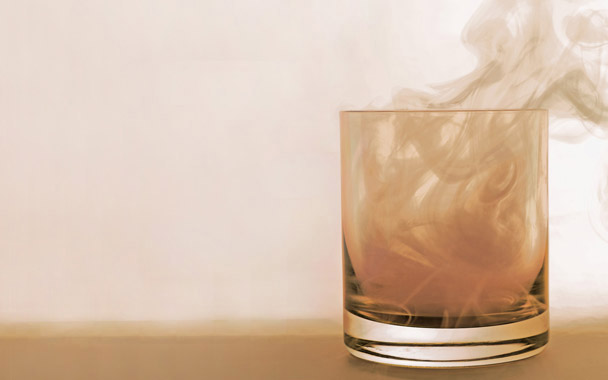You may have bellied up to a bar in recent months, picked up the cocktail menu, and seen such ingredients as gin infused with Lapsang souchong, Coca-Cola syrup that had been poured into pans that were then snuggled into smoldering cherrywood, or rye whiskey through which cigar smoke had been pumped using the aerator from a fish tank. If none of this sent you running for the nearest beer tap, perhaps you found yourself wondering what was going on. Could bartenders be trying to compensate for widespread public smoking bans? Having embraced a culinary approach to cocktails, are they now looking to get out of the kitchen and into the backyard? Maybe they’re just jealous of all the cool new gizmos chefs get to play with? (If that’s the case, can sous vide cocktails be far behind?
Robert Heugel, co-owner of the recently opened Anvil Bar & Refuge, in Houston, is the rye-loving aquarist (no fish are harmed in the making of his cocktails). “I’m from Texas, so naturally I like smokiness,” says Heugel. “And I think it’s underutilized in drinks. People tend to drink safely, but if you challenge them with something familiar, like smoke, you can break down barriers.” Heugel is now making a bitters with his smoked rye, putting various fruits in his smoker (pineapple works well; mango doesn’t), and using Qi Black Tea Liqueur in a variety of cocktails.
Last year, Daniel Shoemaker, co-owner of the Teardrop Cocktail Lounge, in Portland, Oregon, got some attention for his smoked ice (ice is exposed to smoke and then refrozen). “Smoke is an incredibly imposing flavor,” Shoemaker says. “I won’t use more than half an ounce of mezcal or a quarter ounce of Laphroaig in a cocktail.” Shoemaker’s preference is to smoke a small amount of an ingredient. “Carpano Antica sweet vermouth is my go-to,” he says. “It’s already got clove, nutmeg, and espresso flavors. Adding a little bit of smoke really works.”
Bartenders lacking access to smoking apparatuses generally turn to a peaty single-malt Scotch from Islay—Ardbeg, Bruichladdich, Laphroaig, and Lagavulin come to mind—but Joseph Swifka, at Eletaria, in New York City, created a delicious cocktail called the Pipe Smoke with Compass Box’s Peat Monster, a magnificent blend of single malts from various distilleries. Islay peat is its dominant flavor component.
It’s possible that the art of distillation came to Islay as early as the late 13th century, and the Irish monks who brought it certainly would have dried their grain using heat from peat fires. Today, although it’s no longer the primary fuel source, peat is still used to flavor the barley. In fact, the current craze on the island is to push the level of phenols—the main class of chemical compounds responsible for smoky flavors—to the limit (the most extreme examples are Bruichladdich’s Octomore and Ardbeg’s Supernova). One might say that Islay is suffering from a peatiness envy problem.
Mezcal distillation doesn’t go back quite as far, but it may predate the arrival of the Spanish. Although the conventional wisdom is that 16th-century Philippine migrants were the first to produce spirits in Mexico, recent excavations near Amatitán, in the tequila-driven state of Jalisco, seem to confirm scientist Joseph Needham’s belief that, long before 1519, native Americans distilled the “mezcal wine” they’d been making for centuries. If that’s true, a pre-conquest Indian would probably recognize the way the single-village mezcals of Del Maguey are made today. Chichicapa, for example, from high in the mountains of Oaxaca, is made from the Espadín agave, which is roasted under a blanket of earth for three to five days using stones heated by a wood fire. Sipped neat, it has an initial agave sweetness, some herbiness, and a very long smoky finish. Given how much most of us love the smell of a wood fire or the taste of, say, bacon, it’s perplexing that smoky drinks can be so polarizing. Intriguingly, Heugel has found that informing customers that a cocktail is smoky can predispose them to like it, so maybe we just need a few thousand more years for our brains to catch up to our taste buds.

